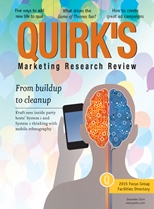Editor’s note: Simon Dunn is creative director at Keen as Mustard Marketing, London.
As a marketing agency working in a niche business area like marketing research, we make it a point to keep an eye on what is going on in research, the mergers and acquisitions as well as the general buzz of business life with people changing jobs and new announcements. We are also very interested when a company rebrands or builds a new Web site. The conversation either falls into two camps, admiration for a job well done or unease at things we feel could have been done better.
But we have also observed a trend: Everything is starting to look the same. Design has always been subject to fashion, as trends are adopted and then quickly dismissed within a year or two. This fickleness is probably best demonstrated by the recent move from photorealistic 3-D-style icons to flat 2-D icons. The most high-profile example of this is Apple, when it changed the design of iOS last year. It could be argued that Apple was in fact late to the game and the first indicator of this trend was Microsoft with Windows 8.
Technology has certainly accelerated the speed of change. At the beginning of the Internet design wasn’t a factor. Everyone went wild with excitement building Web sites without any design skill or consideration – just pure enthusiasm for this new medium. Over time the aesthetic was introduced and the evolution of Web standards meant that designers and coders were less restricted by the technology and beautifully-designed Web sites began to flourish.
Recently there has been a jump in both the design and technology of Web sites in the form of the parallax scrolling Web site. This is essentially a long page with a lot of sections; the name parallax comes from different elements on the page scrolling at different speeds.
This presents an interesting new way for Web pages to work – arguably the first significant change since the start of the World Wide Web. The downside is that we have seen a homogenization in designs and increasingly see very similar site styles – making us wonder what could cause this design coalescence.
We think it’s that most designers are looking over one another’s shoulders. With the proliferation of visual social media such as Behance and Pinterest, everyone is copying everyone else like a magpie bringing to the nest everything that is shiny and new.
Why is this trend the case in Web design but not in brochure design or other collateral? This is probably down to the nature of the technology. Unlike print, a Web site is something that can be continually tweaked and adjusted. Sites can evolve with input from designers and also unconsciously from visitors to the site whose behavior is tracked with Google Analytics.
This is essentially design by committee on a vast scale born from our continual need to see and adopt what others are doing and our obsession with tweaking and optimizing.
Standing out from the rest
So how do we avoid this? Well, companies need to know what they stand for and be brave. Only ever start the design of your Web site with a full understanding of who you are and what you want your site to do. Always use a creative brief to work with your designer and make sure you use it to discover your own secret sauce.
Above all, be authentic and don’t compromise. You don’t have to make changes to your site just because 4.35 percent of visitors are slightly confused by the use of green to indicate a link. Most of all, just because someone else is doing it doesn’t make it right. We are all unique with various strengths and qualities – let’s differentiate not homogenize.
